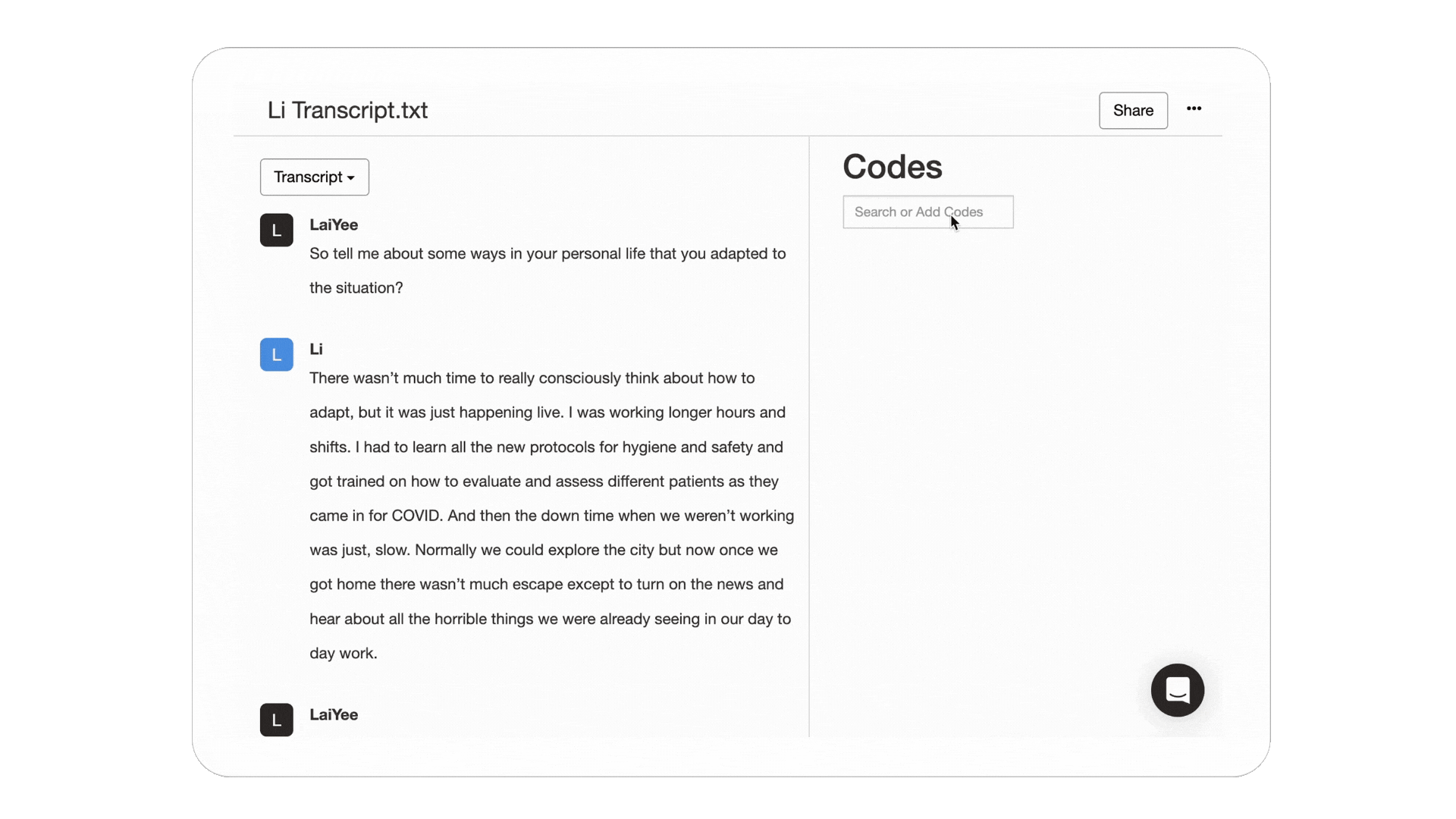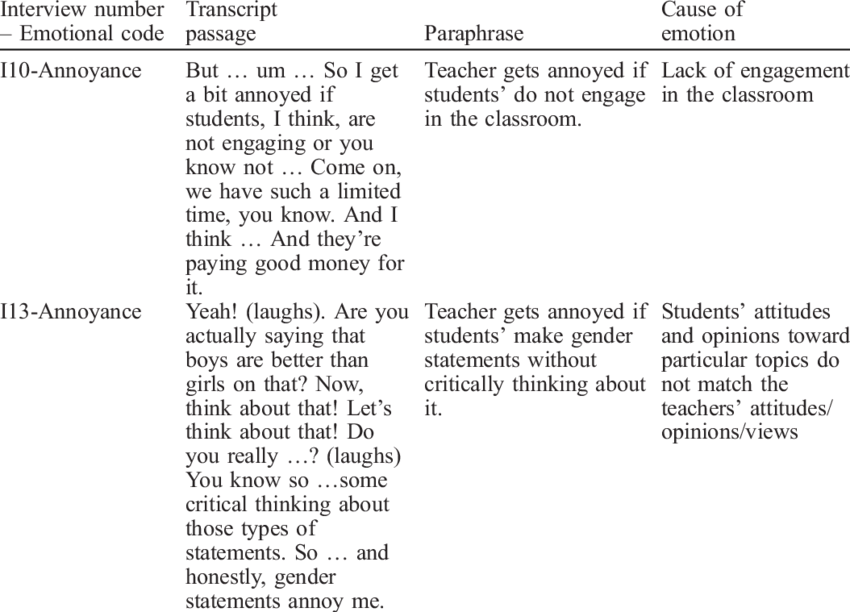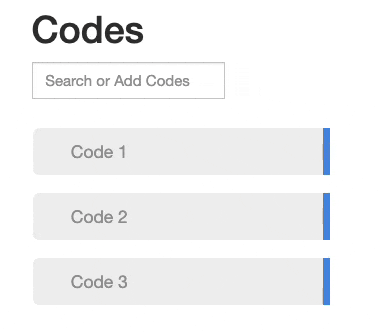How to Do Emotion Coding in Qualitative Research
Peeling back the emotional layers in your interview transcripts can feel impossible. You're trained to look for patterns in qualitative data, and might not feel as prepared to analyze emotional cues in interviews. But these feelings are packed with deeper insights about your participants that are worth digging for. Emotion coding gives you a system to bridge this gap between raw data and emotional understanding.
In this guide, we'll walk through emotion coding – what it is, when to use it, and how to use it more effectively in your research. You’ll also learn how qualitative data analysis tools like Delve make the process more manageable by helping you organize and track emotional patterns across your data.
📘 New to qualitative coding?
If you're just getting started or need a refresher, our free coding course walks you through the basics. For a deeper dive, check out the qualitative coding guide for hands-on tips and best practices.
The basics of emotion coding: Finding the feelings
Qualitative research is inherently emotional work. Whether interviewing participants about difficult experiences or observing a classroom, emotions are part of your data (and your analysis). Emotion coding classifies these emotional expressions using keywords, tones, and non-verbal cues that hint at specific emotions.
From joy to fear or pride, emotion coding helps you recognize the emotional undercurrents shaping your data. For instance, when a participant describes their first day at a new job with phrases like "my stomach was in knots" or "I couldn't stop smiling," you might code these as "anxiety" and "excitement." It is a way to focus on the raw, unstructured data that highlights the emotional narratives at play.
As a first-cycle coding method, emotion coding sets the stage for deeper, more refined second-cycle methods like pattern coding. It’s like an initial classification of your data that gives structure to the thematic development and interpretive work that comes later. Coding emotions like this helps uncover meaning and context that might otherwise stay hidden, improving the richness and rigor of your work.
Why emotion coding matters
Saldaña (2011) suggests that “virtually everything we do has an accompanying emotion(s).” Since emotions are a universal human experience, emotion coding offers valuable insights in fields like social science, healthcare, and market research. You can use it to uncover more than just individual emotions but “possibly the underlying mood or tone of a society,” or what Saldaña calls “its ethos.”
Emotion coding matters because it provides deep insight into your participants' perspectives, worldviews, and life conditions. By systematically identifying and analyzing emotions, you gain a fuller understanding of how your participants relate to particular issues, experiences, or even products.
💡 Coding tip
Writing analytical memos as you identify emotions helps track your thought process. With Delve, you can attach memos directly to emotional codes with just a few clicks, creating a valuable record of your interpretations as you work.
Emotion coding versus other first-cycle methods
Emotion coding is one of several first-cycle methods you can use in your initial coding analysis. At this early stage, you’re examining the data in its raw form and beginning to categorize it based on characteristics you’ve identified. You’re wrapping your arms around the data the best you can.
Here's how it compares to other common approaches:
🗒️ Coding example: First-cycle methods
Transcript excerpt: “Ever since the system update, I’ve been stuck redoing tasks over and over. I'm exhausted.”
| Method | Focus | Example Code |
|---|---|---|
| Emotion coding | Labels emotional experience | Frustration |
| In vivo coding | Uses participant’s exact words | “Stuck redoing tasks” |
| Process coding | Captures ongoing actions | Redoing work |
| Magnitude coding | Rates intensity of experience | Exhaustion: High (3/3) |
| Values coding | Highlights beliefs or priorities | Values efficiency |
Reference: Delve Qualitative Data Analysis Software
Unlike these other approaches, emotion coding specifically targets the feelings expressed through your data. After completing the first-cycle coding, the second-cycle methods, such as pattern coding, axial coding, or thematic analysis, take over. These involve reassembling the data in new ways to find overarching themes or connections between the categories you established in the first cycle.
💡 Choosing the best fit
There are many first-cycle coding methods available, and the best fit will depend on your research topic, type of data, and analytical goals. For an in-depth look at how to code or make this decision, check out our Essential Guide to Qualitative Analysis.
Real-world example of emotions coding
Consider how emotion coding was used in the study by Volet et al. (2013), focusing on university teachers' emotions. They used emotion coding to analyze interview data, resulting in a codebook that revealed a spectrum of emotions – from “joy/humor” to “sadness” and “annoyance.”
The first image from their research shows how a table categorizes emotions into positive and negative, aligning them with specific themes such as the intrinsic value of teaching or the level of student engagement. This table exemplifies how emotion coding can be used not only to identify emotions but also to connect them with underlying themes within the research context.
Image 1: Example of an emotion coding scheme from Volet et al. (2013)
Below, the transcript coded for 'Annoyance,' shows how the team pinpointed places where a teacher expressed annoyance with contextual evidence. The paraphrase helps clarify the cause of the emotion, indicating how these insights can contribute to a deeper understanding of teachers' experiences. These emotion codes, paired with memos, give insight into not just what the emotion is, but why it’s occurring.
Image 2: Coded transcript example (Volet et al., 2013) – a segment of an interview is marked with the code "Annoyance."
The bar graph depicts the frequency of reported positive emotions among the teachers. It visually represents the prevalence of each emotion code (e.g., joy, enthusiasm, pride), offering a bigger picture perspective on the qualitative data. This kind of visual representation can be particularly telling in understanding the emotional landscape of the participants as a group.
Image 3: Frequency of emotion codes in Volet et al. (2013). The bar chart shows how often each positive emotion (like enthusiasm, pride, contentment) was coded across all the data.
This is a real-world study that shows us how emotion coding turns feelings into real insights. By coding emotional expressions and examining their context, the researchers identified patterns (like which positive emotions were most frequent) and tied them back to aspects of the teaching experience.
In Delve, you can do something similar by generating a Code x Transcript matrix as you can see below or exporting your codes as a CSV to quickly spot which emotions appear most often. This helps you zero in on high-frequency codes and uncover deeper themes across your dataset.
When building your own emotion codebook, consider grouping emotions by type (e.g., frustration, pride, anxiety) and linking them to broader categories like motivation, communication, or performance. This helps turn raw emotional data into patterns you can analyze.
Beyond feelings: When to use emotion coding
Emotion coding is a versatile first-cycle method that can be used with everything from content analysis to grounded theory, thematic analysis, and ethnography. Saldaña points out that emotion coding is particularly useful when exploring “interpersonal participant experiences and actions,” especially for research topics related to identity, social relations, reasoning, decision-making, judgment, and risk-taking. This includes:
When studying sensitive topics where emotions tell the real story
To understand how feelings influence people's choices and behaviors
When exploring relationships and how people interact with each other
To see how emotions shape experiences of conflict and teamwork
When researching how places like schools or hospitals affect how people feel
Some of the most interesting findings come from contrasting what people say with the emotions underlying their words. A participant might verbally claim they're "fine" with a policy change while their emotional cues suggest frustration. Delve helps you capture these contradictions by letting you code the same excerpt with multiple codes.
Whether you need to analyze emotional content in content analysis, understand participants' feelings about a specific topic in grounded theory, or interpret cultural nuances and emotions in ethnographic studies, emotion coding is for digging into the emotional features of your data in an organized way.
💡 Easy code application with Delve
Tools like Delve make it easy to apply emotion codes and build a codebook. It’s as simple as highlighting text and typing a label. This shortens the organizational and administrative parts of your research, letting you focus on discovering meaningful patterns instead of managing your system. Learn how to apply a code.

Questions for emotion coding
Let’s quickly cover some key questions to ask yourself when using emotion coding:
What emotions keep showing up in your interviews or observations?
Do you see similar emotional patterns across different participants?
How do your own feelings about the topic affect how you see the data?
What bigger story do these emotional patterns tell about your research question?
These questions help you move beyond simply identifying emotions to using them as analytical tools that deepen your understanding. Now, let’s look at how to do emotion coding without getting overwhelmed.
💡 Emotion coding with Delve
Emotion coding transforms interview transcripts into emotional blueprints. By systematically tracking feelings, you can:
- Uncover hidden narratives beneath surface-level responses
- Translate subjective experiences into analyzable patterns
- Reveal the emotional landscape underlying participant stories
It’s not easy building a flexible code set, mapping emotional tone with care, and grounding your interpretations in context. With Delve’s Code Pages, you can assign emotion codes using custom tags and quickly review and compare emotional patterns across participants.

A simple, step-by-step guide to emotion coding
Using emotion coding in your research means staying alert to feelings that shape participants' experiences. As you use this guide, remember to regularly ask yourself the questions we covered in the previous section.
1. Data collection - Gather emotion-rich sources
Start with data sources likely to contain emotional content. Semi-structured interviews and focus groups typically yield the richest emotional data, especially when discussing personal experiences or challenging situations. You might also gather personal diaries, open-ended survey responses, or any text where people share feelings and experiences.
During interviews, pay attention to:
Verbal cues (tone, word choice, pauses)
Non-verbal signals (facial expressions, gestures)
Stories and anecdotes (often containing emotional peaks)
Make sure to note these observations right away. Details can fade quickly when you’re working with an entire stack of interview transcripts. If you want to keep all these transcripts together in one place, Delve’s drag-and-drop import feature makes it easy to set up your project.
2. Immersion - Get a feel for the emotional landscape
Before formal coding, read through (or listen to) your data multiple times. Focus on the emotional tone without trying to label anything yet. Jot down any especially strong emotions or memorable moments. This helps you notice recurring emotional “threads” before you start categorizing.
Consider this excerpt from a teacher describing their first day in a remote classroom:
🗒️ Emotion coding example
“The moment I set up my home workstation, I just knew it would be a much lonelier experience. My heart started racing, and I kept thinking, ‘This is going to be a lonely experience for teachers, but worse for students.’”
Reference: Delve Qualitative Data Analysis Software
You’re not coding yet but gathering ideas as you read and reread. You might note intense Loneliness, physical stress responses, and self-doubt. The teacher experienced strong negative anticipation before anything actually happened.
Delve's clean interface makes this initial review easier by displaying your transcripts in a distraction-free environment. These early observations often form the foundation for your coding scheme. When you add codes, Delve’s memo feature lets you keep these insights directly alongside the codes in your codebook.
3. Structure - Develop your emotion codebook
After your first pass, create a preliminary list of emotion codes based on the patterns you noticed (e.g., annoyance, loneliness, excitement, happiness). Some codes come straight from participant language (“I felt sad” becomes Sadness), while others come from your interpretation (a motivated day might get Enthusiasm even if the participant never said that word). In your codebook, you can quickly add each of these as shown below:
Remember, you still aren’t applying these codes at this point, just setting yourself up for next steps. If we pull out Loneliness, this is how you set these up in your codebook:
If you’re studying the impact of remote education on educators, your initial code list might include Loneliness, Frustration, Enthusiasm, and more.
With Delve, you can quickly type in and create each of these codes, define them, and then apply them in the next section.
4. Analysis: Apply codes to your data
Now, go through the data again and apply your codes more formally. Highlight each meaningful segment, whether it’s a sentence, phrase, or paragraph, and tag it with one or more emotion codes. Be ready to tweak or expand your code list if you derive new themes.
If you notice multiple anxiety-related codes, consider nesting them under a broader “Anxiety” category to keep your codebook organized. For instance, let’s look at how you could code this exceprt: "The moment I walked into that classroom, I just knew it was going to be a disaster. My heart started racing, and I kept thinking, ‘I can’t do this.’"
🗒️ Coded excerpt: Emotional response under pressure
“The moment I walked into that classroom I just knew it would be a much lonelier experience1. My heart started racing2, and I kept thinking, ‘I can’t do this.’3”
Theme: Anxiety
This theme captures emotional and physical responses to anticipated stress or threat. These moments often surface before any concrete event occurs, rooted in perceived challenges.
Code1: Anticipatory Anxiety
Definition: Emotional tension triggered before the event even occurs, often rooted in uncertainty about what’s to come.
Code2: Physical Manifestation of Anxiety
Definition: Describes physical symptoms of emotional stress such as racing heart, shaking, or shallow breathing.
Code3: Self-Doubt
Definition: A moment of internal hesitation or lack of belief in one’s ability to succeed or manage a situation.
Reference: Delve Qualitative Data Analysis Software
As you code, keep a close eye on:
Direct emotional statements (“I was so frustrated”)
Emotional metaphors (“My heart sank”)
Physical descriptions (“My hands were shaking”)
Shifts in emotional tone within the same response
In Delve, you can just highlight and add a code with a click. You can also nest related codes under main categories directly in your codebook. But remember, this is a first-cycle coding approach, so try not to overcomplicate it. Keep an eye on your time commitment and stay flexible. This way, you can keep track of emotional nuances without getting sidetracked by every emotional thread.
5. Synthesis: Look for patterns and relationships
After coding, step back and see how different emotions connect to each other and to your research question:
Which emotions cluster together?
How do emotions evolve over time or across situations?
Are there contradictions between stated and implied emotions?
Delve's co-occurrence matrices are one way to visualize these relationships, showing you which emotion codes frequently appear together across your dataset. The codes page feature also displays all your codes in one location and how many times they have each been applied, so it’s easier to spot overlapping codes, see where to split or merge codes (below), or which emotions keep popping up.
Your emotion codes provide powerful insights into the human side of your data, but they come with a few hurdles worth noting. Below are some common challenges and practical ways to handle them.
Heads up: Common challenges of emotion coding
While emotion coding offers rich insights, researchers often encounter several challenges along the way. Let's explore these obstacles and practical solutions:
Challenge 1: Drawing lines between similar emotions
How do you differentiate between closely related emotions like disappointment and sadness, or anxiety and fear? Without clear boundaries, your coding can become inconsistent.
Solution: Create detailed code definitions that specify the distinguishing features of each emotion. You can easily document these nuances in code descriptions with Delve and easily reference them during coding to maintain consistency.
💬 Practical example - For the codes "Disappointment" and "Sadness," you might define disappointment as involving unmet expectations, while sadness reflects a more general feeling of sorrow not necessarily tied to expectations.
Challenge 2: Reading between the lines
Participants don't always explicitly name their emotions. Feelings may come through in many different forms, like stories, metaphors, or body language.
Solution: Use analytical memos to document implied emotions and contextual clues. Delve allows you to attach memos directly to coded excerpts, keeping interpretations transparent.
Challenge 3: The researcher in the mirror
Your own emotional responses inevitably influence how you perceive and code emotions in your data. Research by Lustick and colleagues (more below) found that researchers are more likely to adjust their emotional responses when working with participants with different levels of privilege or power.
Solution: Keep practicing reflexivity by writing memos about your reactions. Rather than trying to remove subjectivity entirely, keep track of it. You can also track your reflections or potential biases in a separate “Reflections” code. This way, you can differentiate actual participant data from your own thoughts. Some researchers share their Delve projects with a colleague (or Delve’s AI feature) for easier peer reviewing.
Challenge 4: From codes to insights
After identifying emotions in your data, the challenge becomes making sense of these codes in relation to your research questions. What story do these emotions tell?
Solution: Delve's co-occurrence matrices help you instantly see which emotions appear together, while code frequency tools show how often certain feelings appear across participants. Review these patterns and dive back into specific snippets to understand why these emotions connect. This combination of visual patterns and detailed analysis transforms your emotion codes into meaningful, data-driven insight.
With these challenges in mind, let’s finish up with what to do next so you can bring all of these strategies and solutions into practice.
Saldaña’s Emotion Coding vs. Lustick’s Emotion Coding: A Quick Note
A quick note before wrapping up: "Emotion coding" can refer to two different qualitative approaches. Throughout this article, we've discussed Saldaña's emotion coding - identifying emotions expressed by participants. However, you might also encounter Lustick's emotion coding (2021), which focuses instead on the researcher's emotional reactions to data as a reflexive practice.
While Saldaña helps you code emotions within your data, Lustick helps you reflect on your reactions to that data. For most applied qualitative studies, Saldaña's approach is the primary method, with Lustick's serving as a complementary practice for enhancing reflexivity.
Emotion coding with qualitative data analysis software
While emotion coding reveals valuable insights, managing emotional data across multiple transcripts can quickly become overwhelming. Without the right tools, it takes a lot more time. This is where purpose-built qualitative data analysis software like Delve becomes invaluable.
Delve streamlines emotion coding with features specifically designed to help you organize, analyze, and interpret emotional data:
Intuitive coding interface: Highlight text and apply emotion codes with just a few clicks
Simple memo system: Attach your reflexive notes directly to coded passages
Visual analysis tools: Explore relationships between emotions using co-occurrence matrices
Flexible organization: Create nested hierarchies to group related emotions
Collaborative features: Work with research teams to develop consistent coding approaches
AI-supported coding: Bounce ideas and reduce the grunt work with AI coding support
These tools help you focus on interpretation rather than administration, letting you develop a more nuanced understanding of your participants' emotional landscapes without getting lost in the details.
Wrapping up with emotion coding
The real power of emotion coding is the ability to access the unspoken dimensions of human experience that might otherwise remain hidden in your data. When combined with reflexive practice and supported by intuitive coding tools like Delve, emotion coding helps you move beyond surface descriptions to develop richer, more nuanced understandings of complex social phenomena.
Ready to wrap your arms around the emotional side of your qualitative data? Start your free trial of Delve today.

Streamline Your Thematic Analysis with Delve | Top-Rated by Researchers ⇒
Rated as a top qualitative coding software on Capterra, Delve simplifies the entire process, making it easier to uncover patterns, collaborate, and produce insights that matter.
Get 14 Days FreeNo commitment. Cancel anytime.
References
Saldaña, J. (2016). The coding manual for qualitative researchers (3rd ed.). SAGE.
Volet, Simone & Hagenauer, Gerda. (2013). "I don't think I could, you know, just teach without any emotion": Exploring the nature and origin of university teachers' emotions. Research Papers in Education. 29. 10.1080/02671522.2012.754929.
Lustick, H., Yang, X., & Hakouz, A. (2024). The Role of Emotions in Qualitative Analysis: Researchers’ Perspectives. The Qualitative Report, 29(4), 1103-1124. https://doi.org/10.46743/2160-3715/2024.6232
Cite This Blog Post
Delve. Ho, L., & Limpaecher, A. (2025, April 21). How to Do Emotion Coding in Qualitative Research https://delvetool.com/blog/emotion-coding


















